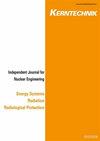基于CFD和机器学习的顶部通风舱内氦被动稀释混合模型
IF 0.9
4区 工程技术
Q4 NUCLEAR SCIENCE & TECHNOLOGY
引用次数: 0
摘要
摘要在核电站安全壳氢气管理中,除了被动自催化重组器(PAR)外,轻质气体的被动稀释也起着重要作用。这可能是一个有吸引力的选择,以优化密封设计和估计稀释的程度。被动稀释在核工业中还有许多其他应用。加拿大人通过体积流放大系数(VFMF)对向上上升的氦羽中的空气夹带和由此产生的氦气稀释的实验研究已用于计算流体动力学(CFD)验证。基于CFD的火焰动力学模拟器(FDS)的VFMF预测值与试验数据吻合较好。在FDS代码验证后,进行了参数化研究,生成了注氢范围、侧开孔面积和开孔高度的VFMF数据库。本研究利用CFD代码生成的数据库,基于两参数关系(即无维氢注入和VFMF)对各种机器学习(ML)模型进行了评估。训练后的ML模型用于预测上升浮力羽流中气体携入(通过开口)的质量流量。机器学习预测与针对测试数据的预测非常一致。发现基于多变量自适应样条回归(MARS)的机器学习模型表现最好,并对其进行了讨论。本文重点介绍了数值模拟的方法、CFD研究的结果和基于机器学习的预测。本文章由计算机程序翻译,如有差异,请以英文原文为准。
CFD and machine learning based hybrid model for passive dilution of helium in a top ventilated compartment
Abstract For hydrogen management in the containment of Nuclear Power Plants (NPPs), besides the Passive autocatalytic Recombiners (PAR), the passive dilution of lighter gas plays an important role. This could be an attractive option to optimize the containment design and to estimate the extent of dilution. Passive dilution has many other applications in nuclear industry. The experimental studies of air entrainment in the upward rising helium plume and the resulting dilution of helium gas by the Canadians in terms of Volume Flow Magnification Factor (VFMF) have been utilized for Computational Fluid Dynamics (CFD) validation. The CFD based Fire Dynamics Simulator (FDS) predicted values of VFMF found to be in good agreement with the test data. After FDS code validation, parametric study has been carried out to generate a data base of VFMF for range of hydrogen injection, side opening area and opening height. In present study various Machine Learning (ML) models are evaluated based on two-parameter relationship i.e. non dimensional hydrogen injection and VFMF using the CFD code generated database. The trained ML models were used for the predictions of the mass flow rate of gas entrainment (through opening) in the rising buoyant plume in terms of VFMF. The ML predictions were in good agreement with the predictions against test data. Multivariate Adaptive Regression Splines (MARS) based ML model found to performed best and discussed in the paper. The paper highlights details of methodology of numerical simulation, results of the CFD studies and machine learning based predictions.
求助全文
通过发布文献求助,成功后即可免费获取论文全文。
去求助
来源期刊

Kerntechnik
工程技术-核科学技术
CiteScore
0.90
自引率
20.00%
发文量
72
审稿时长
6-12 weeks
期刊介绍:
Kerntechnik is an independent journal for nuclear engineering (including design, operation, safety and economics of nuclear power stations, research reactors and simulators), energy systems, radiation (ionizing radiation in industry, medicine and research) and radiological protection (biological effects of ionizing radiation, the system of protection for occupational, medical and public exposures, the assessment of doses, operational protection and safety programs, management of radioactive wastes, decommissioning and regulatory requirements).
 求助内容:
求助内容: 应助结果提醒方式:
应助结果提醒方式:


